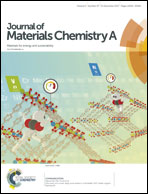Tracking the confinement effect of highly dispersive carbon in a tungsten oxide/carbon nanocomposite: conversion anode materials in lithium ion batteries†
Abstract
A variety of transition metal binary compounds, whose reaction mechanism involves intercalation-initiated conversion, have been extensively studied as anode materials in lithium ion batteries (LIBs). Although the introduction of carbonaceous materials such as carbon nanotubes, graphene, or a carbon layer solved issues arising from the conversion reaction during repetitive cycles, a perfect electrical contact of the carbonaceous material with the discharge products on a few-nanometer scale has been rarely accomplished. Moreover, most of the previous studies have focused on maximizing the electrochemical performance without an in-depth understanding of the fundamental effect of each component in the nanocomposite. Herein, an ordered mesoporous tungsten oxide/carbon composite with ultra-highly dispersed carbon over a few-nanometer scale is prepared by the self-assembly of a block copolymer with inorganic/carbon precursors. The confinement effect of tungsten oxide within the nanowalls (∼10 nm) is comprehensively investigated by electrochemical transient analysis and various ex situ analytic methods including X-ray diffraction and X-ray absorption spectroscopy. The resulting electrode provides an excellent cycle and rate performance owing to the highly conductive and stable matrix that endures repetitive conversion reactions.



 Please wait while we load your content...
Please wait while we load your content...